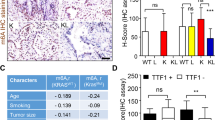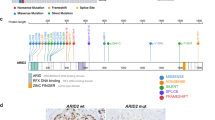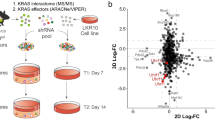Abstract
Genetic alterations in Rb2/p130 gene have been reported in several tumors, but till now there are insufficient and conflicting data linking the loss of pRb2/p130 expression with the mutational status of this gene in lung cancer. We recently reported that loss or lowering of pRb2/p130 expression is mainly due to aberrant Rb2/p130 promoter methylation, in retinoblastoma tumors, and indicated that epigenetic silencing of Rb2/p130 can impair its function to negatively regulate cell cycle progression as well as apoptotic response. In order to clarify Rb2/p130 gene inactivation in lung cancer, we investigated whether epigenetic events could impair the expression of this gene in NSLC. Here, we show that specific Rb2-exon 1 homozygous mutations, occurring in an Rb2/p130, region, rich in CpG dinucleotides, could be the ‘hit event’ that predispose this gene to epigenetic changes, leading to Rb2/p130 gene silencing in lung cancer. Moreover, these homozygous mutations, found in different tumor histotypes, could represent tumor-specific markers.
This is a preview of subscription content, access via your institution
Access options
Subscribe to this journal
Receive 50 print issues and online access
$259.00 per year
only $5.18 per issue
Buy this article
- Purchase on Springer Link
- Instant access to full article PDF
Prices may be subject to local taxes which are calculated during checkout




Similar content being viewed by others
References
Baldi A, Esposito V, De Luca A, Fu Y, Meoli I, Giordano GG, Caputi M, Baldi F and Giordano A . (1997). Clin. Cancer Res., 3, 1691–1697.
Belinsky SA . (2004). Nat. Rev. Cancer, 4, 707–717.
Cinti C, Claudio PP, Howard CM, Neri LM, Fu Y, Leoncini L, Tosi GM, Maraldi NM and Giordano A . (2000). Cancer Res., 60, 383–389.
Claudio PP, Howard CM, Pacilio C, Cinti C, Romano G, Minimo C, Maraldi NM, Minna JD, Gelbert L, Leoncini L, Tosi GM, Hicheli P, Caputi M, Giordano GG and Giordano A . (2000). Cancer Res., 60, 372–382.
Hannon GJ, Demetrick D and Beach D . (1993). Genes Dev., 7, 2378–2391.
Helin K, Holm K, Niebuhr A, Eiberg H, Tommerup N, Hougaard S, Poulsen HS, Spang-Thomsen M and Norgaard P . (1997). Proc. Natl. Acad. Sci. USA, 94, 6933–6938.
Kalebic T . (2003). Ann. Acad. Sci., 293, 278–285.
La Sala D, Macaluso M, Trimarchi C, Giordano A and Cinti C . (2003). Oncogene, 22, 3518–3529.
Li Y, Graham C, Lacy S, Duncan AM and Whyte P . (1993). Genes Dev., 7, 2366–2377.
Macaluso M, Cinti C, Russo G, Russo A and Giordano A . (2003a). Oncogene, 22, 3511–3517.
Macaluso M and Giordano A . (2004). Tumori, 90, 367–372.
Macaluso M, Montanari M, Cinti C and Giordano A . (2005a). Semin. Oncol. (in press).
Macaluso M, Montanari M and Giordano A . (2005b). Ann. Oncol., 16 (Suppl 4), iv20–iv22.
Macaluso M, Paggi MG and Giordano A . (2003b). Oncogene, 22, 6472–6478.
Mayol X, Grana X, Baldi A, Sang N, Hu Q and Giordano A . (1993). Oncogene, 8, 2561–2566.
Modi S, Kubo A, Oie H, Coxon AB, Rehmatulla A and Kaye FJ . (2000). Oncogene, 19, 4632–4639.
Nephew KP and Huang TH . (2003). Cancer Lett., 190, 125–133.
Russo G, Claudio PP, Fu Y, Stiegler P, Yu Z, Macaluso M and Giordano A . (2003). Oncogene, 22, 6959–6969.
Scarano MI, Strazzullo M, Matarazzo MR and D'Esposito M . (2005). J. Cell. Physiol., 204, 21–35.
Suzuki M, Shigematsu H, Takahashi T, Shivapurkar N, Sathyanarayana UG, Iizasa T, Fujisawa T and Gazdar AF . (2005). Lung Cancer, 47, 309–314.
Tosi GM, Trimarchi C, Macaluso M, La Sala D, Ciccodicola A, Lazzi S, Massaro-Giordano M, Caporossi A, Giordano A and Cinti C . (2005). Oncogene (in press).
Xue Jun H, Gemma A, Hosoya Y, Matsuda K, Nara M, Hosomi Y, Okano T, Kurimoto F, Seike M, Takenaka K, Yoshimura A, Toyota M and Kudoh S . (2003). Mol. Carcinog., 38, 124–129.
Yokota J and Kohno T . (2004). Cancer Sci., 95, 197–204.
Zochbauer-Muller S, Minna JD and Gazdar AF . (2002). Oncologist, 7, 451–456.
Acknowledgements
We thank Dr D La Sala and Dr A Zamparelli for technical help and Dr C Trimarchi for helpful and constructive comments on the manuscript. This study was supported by NIH-RO1 CA066999-09A2 grant, Sbarro Health Research Organization (WWW.SHRO.ORG) and AIRC grants to AG, and by Murst Lag-CO3, Consiglio Nazionale delle Ricerche (CNR), Ministero della Sanita' grants to CC. Dr Marcella Macaluso is supported by an FIRC (Fondazione Italiana per la Ricerca sul Cancro) fellowship.
Author information
Authors and Affiliations
Corresponding author
Rights and permissions
About this article
Cite this article
Caterina, C., Marcella, M. & Giordano, A. Tumor-specific exon 1 mutations could be the ‘hit event’ predisposing Rb2/p130 gene to epigenetic silencing in lung cancer. Oncogene 24, 5821–5826 (2005). https://doi.org/10.1038/sj.onc.1208880
Received:
Accepted:
Published:
Issue Date:
DOI: https://doi.org/10.1038/sj.onc.1208880
Keywords
This article is cited by
-
Hepatitis C virus core protein modulates pRb2/p130 expression in human hepatocellular carcinoma cell lines through promoter methylation
Journal of Experimental & Clinical Cancer Research (2015)
-
The retinoblastoma gene Rb and its family member p130 suppress lung adenocarcinoma induced by oncogenic K-Ras
Oncogene (2009)
-
Rb2/p130 is the dominating pocket protein in the p53–p21 DNA damage response pathway leading to senescence
Oncogene (2009)
-
A small molecule based on the pRb2/p130 spacer domain leads to inhibition of cdk2 activity, cell cycle arrest and tumor growth reduction in vivo
Oncogene (2007)



